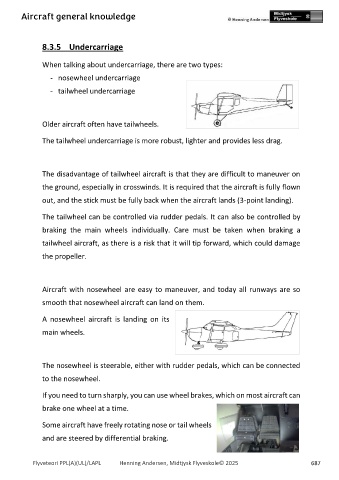Page 687 - PPL-engelsk 2025
P. 687
Aircraft general knowledge
8.3.5 Undercarriage
When talking about undercarriage, there are two types:
- nosewheel undercarriage
- tailwheel undercarriage
Older aircraft often have tailwheels.
The tailwheel undercarriage is more robust, lighter and provides less drag.
The disadvantage of tailwheel aircraft is that they are difficult to maneuver on
the ground, especially in crosswinds. It is required that the aircraft is fully flown
out, and the stick must be fully back when the aircraft lands (3-point landing).
The tailwheel can be controlled via rudder pedals. It can also be controlled by
braking the main wheels individually. Care must be taken when braking a
tailwheel aircraft, as there is a risk that it will tip forward, which could damage
the propeller.
Aircraft with nosewheel are easy to maneuver, and today all runways are so
smooth that nosewheel aircraft can land on them.
A nosewheel aircraft is landing on its
main wheels.
The nosewheel is steerable, either with rudder pedals, which can be connected
to the nosewheel.
If you need to turn sharply, you can use wheel brakes, which on most aircraft can
brake one wheel at a time.
Some aircraft have freely rotating nose or tail wheels
and are steered by differential braking.
Flyveteori PPL(A)(UL)/LAPL Henning Andersen, Midtjysk Flyveskole© 2025 687

